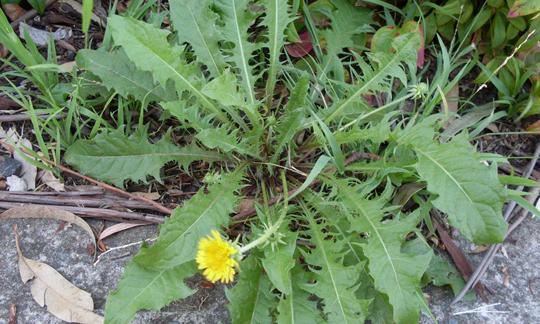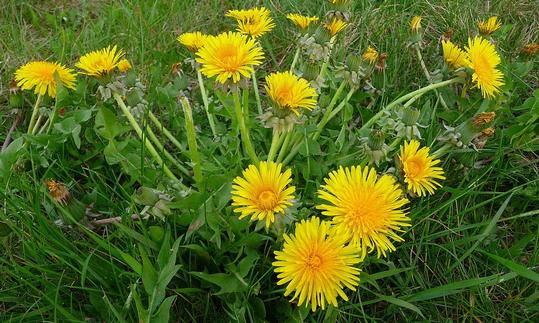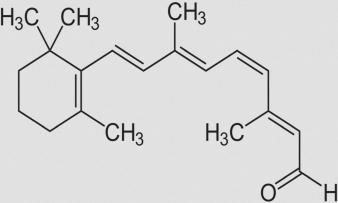Table of contents
The common dandelion ( Taraxacum sect. Ruderalia syn. officinalis ) is the best-known species of the dandelion genus ( Taraxacum ) in Central Europe. The root, flower, stem and leaf of the plant, colloquially known as the dandelion clock , can be eaten raw .
Use in the kitchen:
Young, fresh dandelion leaves can be used raw from March to June as a salad delicacy (Austria: “Röhrlsalat” 1 ) or cooked as a vegetable. The slightly bitter taste of the young leaves goes well with juicy tomatoes , mildleaf lettuce and potatoes . Finely chopped and after steeping in water or salt for an hour, even older leaves lose a large part of their bitter substances. The leaves are ideal for preparing wild herb pesto or spinach. All recipes with spinach can also be prepared with dandelion leaves. Dried leaves serve as a seasoning and go well in a wild plant salt. 2
The flower buds of the dandelion can be harvested in March and April and made into a delicious chutney. They can be fried as a vegetable or pickled in vinegar . They also taste like a delicious snack when eaten raw. 2
From March to September (especially in May), the decapitated flowers can be used to make wine or a honey-like jelly (French cramaillotte, with orange , lemon and sugar 1 ). The flowers can be added to tea, salads or vegetables and the cut flower tips can be used as a decoration for desserts. 2
Even the stems can be used as a vegetable or salad ingredient from April to September. You cut them lengthways and leave them to soak in salt or water so that they roll up. 2
From September to March, the grated roots can be added to hearty winter salads. If you let the grated or chopped roots steep in salt or water, they will also lose their bitterness. The roots can be added to baked or braised vegetables, and ground and roasted to make a caffeine-free coffee substitute. 2
Just like the roots, the flowers and leaves are also used as a metabolism-stimulating tea. These parts of the plant can be gently dried at 40 °C. This means you can benefit from this medicinal plant at any time without having to collect it fresh every time.
Recipe for dandelion blossom syrup (the vegan honey alternative): Simmer
200 g of dandelion petals with a litre of water, the slices of a lemon and a pinch of vanilla for 30 minutes. If you like, you can add two broken cardamom pods , cinnamon sticks or star anise . If you prefer a vegan forest honey alternative, add about 50 g of young spruce or fir shoots. Cover the mixture and leave to steep overnight at cool room temperature. Then pour the mixture through a kitchen towel. Boil the liquid with a kilogram of sugar for at least two to three hours. The cooled liquid should have a viscous consistency, similar to acacia honey. As a gelling test, allow some of the liquid to cool in the refrigerator. Pour the hot mixture into sterilized jars and seal.
Recipe for dandelion spinach:
Cut 300 g of young, tender dandelion leaves into strips and cook them in vegan vegetable stock for 10 minutes so that they lose some of their bitter substances. Pour off some of the water and thicken with a little flour if desired. Finely chop another 100 g of dandelion leaves and mix into the dandelion spinach. Season with salt,pepper and nutmeg . Enough for two to four people.
Recipe for dandelion tea:
Pour a cup of boiling water over a tablespoon of dried dandelion roots, flowers and/or leaves and let it steep for ten minutes. Drink two to three cups of this tea daily for a limited period of two months, e.g. during a spring cure.
Of course, you can also make the tea with fresh leaves, fresh roots or fresh flowers. The leaves are cut into fine strips, the cleaned and fresh roots are placed in water the night before and the flowers are used whole. Cut the roots into thin slices or grate them before pouring about 300 ml of boiling water over the wild herbs. After ten minutes, the tea can be strained.
A recipe for healthy potato salad with dandelion can be found at this link .
| Not only vegans or vegetarians should read this: Vegans often eat unhealthily. Avoidable nutritional mistakes . |
Shopping - where to buy?
Fresh dandelion leaves can rarely be bought at weekly markets, but more often in Turkish supermarkets. Dried leaves in the form of tea can be purchased in drugstores, pharmacies, organic shops and online.
Dandelion tea is available in bulk or in the form of tea bags. Pharmacies and drugstores also sell drops, tea blends, juices and tablets containing dandelion. 3
Finding wild plants - Season:
Before collecting wild plants, it is generally advisable to first find out about the plant in question with the help of a profile or a wild plant description.
How tall does the dandelion grow? The common dandelion ( Taraxacum sect. Ruderalia ) is a perennial, herbaceous plant that grows to a height of 10 to 30 cm. All parts of the plant contain a non-toxic, white milky sap. The long, fleshy taproot is dark brown to black on the outside and up to one meter long, rarely up to two meters. The 10 to 30 cm long leaves are incised and toothed. The inflorescence stalks are hollow, up to 60 cm long and have the inflorescence bud at the top, which develops into the well-known yellow basket flower and later into hairy parasols (pappus). 1
In Central Europe, the common dandelion is found as a common wild herb in meadows, on roadsides, in sparse forests and in gardens. The spread of dandelions is greatly encouraged by changes in grassland management. 4 Other locations include fallow land, scree slopes and cracks in walls, which the dandelion quickly colonizes as a ruderal plant. In the mountains, dandelions grow on alpine meadows up to altitudes of 2,800 m, although they are significantly smaller there than in the lowlands. 1
The younger the common dandelion is, the fewer bitter substances it contains. The preferred months for collecting it are April and May. However, the different parts of the plant are in season practically all year round. Roots harvested in autumn taste sweet because the plant's nutrients migrate back into the roots.
There is no danger of confusion with similar-looking poisonous plants. However, dandelions can easily be confused with other species of the same genus. However, these are all also edible.
As is generally the case when collecting wild plants, you should take a close look at the place where you are collecting. You should not collect on paths, roads or in places where there are a lot of dogs.
Storage:
Leaves and flowers should be eaten fresh (raw) or processed quickly to obtain the maximum benefit of delicate vitamins. The roots can be dried well or stored wrapped in a towel in the vegetable compartment of the refrigerator.
Ingredients - nutritional value - calories:
Common dandelion contains bitter substances, triterpenes, carotenoids, phenolic compounds, 3 flavonoids, coumarins, phytosterols and mucilage. In spring, the roots contain 2% inulin, in autumn it is 40%. The potassium content (approx. 4.5% in the herb and 2.5% in the root) is responsible for the diuretic healing effect. 2
Compared to 100 g of lettuce, 100 g of dandelion leaves contain 778 µg, which is about 10 times more vitamin K and therefore covers more than 1,000% of the daily requirement, similar to raw chard and kale . 5 Vitamin K is insensitive to heat and oxygen. Ionizing radiation and UV light, however, lead to rapid destruction. 6
All other vitamins and minerals are many times higher than in lettuce. For example, dandelion leaves contain three times more vitamin A (than RAE retinol equivalent), which corresponds to covering 64% of the daily requirement. The 35 mg vitamin C content in dandelion leaves is also 9 times higher than in lettuce, thus covering 44% of the daily requirement. Dandelion leaves can also serve as a source of calcium and iron , as they contribute more than 20% to the daily requirement. Detailed information on other nutrients can be found in the nutritional tables below. 5
Despite the good nutritional balance of dandelion, the term superfood is somewhat exaggerated, but would be more accurate than for many other, high-priced products!
Health aspects - effects:
The high inulin content in the roots in autumn is one of the special features of dandelions. Inulin is an indigestible oligosaccharide and is a water-soluble dietary fiber. It is an important prebiotic that serves as food (substrate) for certain, desirable colon bacteria such as lactobacilli, eubacteria or bifidobacteria and thus promotes their proliferation. 7
Observational studies confirmed the positive effect of vitamin K on the risk of osteoporosis and the occurrence of cardiovascular diseases. Further intervention studies confirmed that vitamin K supplementation reduced bone loss. However, these studies used extremely high doses that are difficult to achieve through diet. 6
Dandelion preparations have digestive, choleretic and appetite-stimulating properties. Dandelion can have a beneficial effect on digestive problems such as a feeling of fullness, flatulence or slow digestion. 3 The bitter substances contained in dandelion are responsible for stimulating the flow of bile. The diuretic effect is well known in naturopathic practice, although this has not yet been clearly proven in the laboratory. 8
Dangers - Intolerances - Side effects:
Contraindications for the consumption of dandelion and dandelion preparations are hypersensitivity, blockage or inflammation of the bile ducts, gallstones, liver disease and stomach and intestinal ulcers. In addition, it is recommended that children under 12 years of age and pregnant and breastfeeding women should refrain from consuming it. 3
Adverse effects may include allergic reactions, stomach discomfort, heartburn and diarrhea. 3,9 Frequent contact with the milky sap of the plant parts may cause skin reactions in sensitive people. These may include brown discoloration that lasts for several days, but also itching (contact dermatitis). 9
What is poisonous about dandelions? The rule of thumb “all plants with white milky sap are poisonous” does not apply to dandelions. Dandelions and their milky sap are not poisonous. 9
Use as a medicinal plant:
The dandelion root of the common dandelion ( Taraxaci officinalis radix ), the dandelion herb ( Taraxaci officinalis herba ) from the above-ground parts of the plant or mixtures ( Taraxaci officinalis herba cum radice ) are used as medicinal herbs. In addition to dry and liquid extracts, capsules are also available. 9
Folk medicine - natural healing:
Dandelion has been known as a medicinal plant since ancient times. In the Middle Ages, the yellow-flowering herb was used to treat jaundice, as the doctrine of signatures allowed conclusions to be drawn about the effect of the plant on the body based on its characteristics. 8 In the past, the milky sap was also used to treat skin diseases.
In folk medicine, dandelion is used as a blood purifier, for digestive problems and as a mild laxative. The milky juice is also used externally for eczema, warts and other skin diseases. 2
Occurrence - Origin:
The common dandelion originates from Europe and western Asia and now grows throughout the northern hemisphere. In the southern hemisphere, the introduced plant is only found sporadically. 1 More than 200 subspecies or variations of the common dandelion have been described for Europe.
Cultivation - Harvest:
If a garden is located in the immediate vicinity of fertile meadows, it can be expected that dandelions will also settle in garden beds and meadows. Dandelions are considered a valuable asset for bees, especially in spring. By mowing the ripening heads in good time, further seeding can be avoided. 4
Danger of confusion:
The common dandelion from the Taraxacum genus is easy to confuse with other species of this genus, sometimes the plants can only be distinguished by the shape of their seeds. There is also a great similarity to dandelion species of the Leontodon genus. The common pigweed, which also comes from the daisy family, also looks very similar to the dandelion. However, the flower stalks of the common pigweed and the Leontodon species are not hollow. Fortunately, there is no health risk from confusion with the species mentioned. 1
Animal protection - species protection - animal welfare:
Dandelions are a remarkably productive forage plant for bees. The early flowering period in spring also promotes the development of bee colonies. This means that dandelion meadows are ecologically far more valuable than a monotonous ornamental lawn. To produce one kilogram of honey, the bees have to visit 125,000 flower heads. 1.4
Dandelions serve as food for bees mainly during the months of April to July (spring harvest) and again in September. Harvest is the general term for the food that bees bring in, i.e. nectar, pollen and honeydew. The nectar value of dandelions is high and the pollen value is very high (nectar value and pollen value scale: none, low, medium, high, very high). These two values reflect the value for insects and serve as guidelines and decision-making aids for new plantings and gardening. 4
General information:
In addition to the common dandelion ( Taraxacum sect. Ruderalia ), there are numerous very similar and closely related plant species. They belong to the genus dandelion ( Taraxacum ) and come from the daisy family ( Asteraceae ). The common dandelion is the best known species and is common in Central Europe. 1
The common dandelion is usually referred to simply as dandelion, which can lead to confusion with the genus Leontodon (dandelion). 1
The English name for the common dandelion is "common dandelion".
The meaning of the name dandelion is easy to explain. It comes from the Latin term "dens leonis", which means "lion's tooth". The deeply incised leaves of the plant are said to be reminiscent of the teeth of a predator.
Alternative names:
There are over 500 different names for dandelion in popular parlance, which reflects the popularity of this traditional medicinal and culinary plant.
Some names are due to the diuretic effect of the dandelion: bed wetter, bed pisser, bed shitter, bed seecher, piss flower, pisser, piss carnation, bed seicher root, seicher root, piss blom, in Holland pissebloem and in France pissenlit.
In Swiss German, these dialect names are known: Chrottepösch(e), Weihfäcke (feathers of a harrier), Milchblueme, Lichtli, Schwieblueme or Söiblueme (“sow flower”).
Other well-known names in German-speaking countries are: Bumbein, Bumbaum, Hundeblume, Hundsblume, Hundszunge, Kuhblume, Pferdeblume, Moadogga, Mühlenbuschen, Dandelion, Rahmstock, Butterblume, Butterstecker, Schmalzblümlein, Milchstöck, Mellichstöck, Millichstöck, Milchblume, Milchthistle, Kettenblume, Kettenkraut, Pfaffenplatte, Pfaffendistel, Pfaffenöhrlein, Röhrlichrut, Marigold, Ringelstock, Laüsblömla, Teufelsblume, Sonnenwurzel, Ackerchori, Wiesenlattich, Hosnblaatle (hare leaves), Hakenlappiger Löwenzahn, Stringer Löwenzahn, Häälestock, Sonnwendlig or Lichtbloom.
Names such as May bush, March bush, May flower refer to the early flowering time of the year.
On Wikipedia you can find the following synonyms for dandelion: Taraxacum sect. Taraxacum (syn.: Taraxacum sect. Ruderalia Kirschner, H.Øllg. & Štěpánek): Common dandelion. 10
Keywords for use:
Dandelions are used as animal feed for pets, e.g. in the form of dandelion pellets. During the Second World War, dandelions were used in Russia and the German Reich as a rubber substitute. Dandelions are also depicted on banknotes, such as the 500 DM banknote from 1992 or the current 50 SFr note. 1
Literature - Sources:










Comments